Japan
Wood Products Prices
Dollar Exchange Rates of 25th
July
2020
Japan Yen 104.92
Reports From Japan
Lockdown lifted but weak global
demand hammers
growth prospects
Japan¡¯s economy is expected to have contracted almost
24% on an annualised basis in the second quarter of 2020
driven down by falling exports and the impact of the state
of emergency which encouraged work from home and
businesses to close. Preliminary second quarter GDP data
will be available mid-August.
The Bank of Japan said it expects the Japanese economy
to shrink 4.7% and the consumer price index to fall 0.5%
in fiscal 2020 ending March 2021.
Japan's industrial activity contracted for the 15th
consecutive month in July suggesting the economic
damage from the pandemic will linger as there is little
hope for a quick recovery in global demand. The lifting of
most lockdown restrictions gave a boost to the domestic
economy but it is still negatively affected by weak
international trade. Japan¡¯s exports crashed in June, the
fourth month of declines.
Subsidised relocation of manufacturing from China
The Ministry of Economy, Trade and Industry has released
the names of the first group of Japanese companies being
subsidised to relocate manufacturing out of China. The
first 87 companies will benefit from the yen 70 billion
fund to move production lines. The Japanese
government¡¯s aim is to reduce reliance on China and build
diversified supply chains. The Ministry said 30 of the 87
companies will shift production to Southeast Asia.
The government has allocated yen 220 billion in the fiscal
2020 supplementary budget to create this subsidy
programme to encourage companies to move. Of the total,
yen 23.5 billion is for those shifting to Southeast Asia.
See:
https://asia.nikkei.com/Economy/Japan-reveals-87-projectseligible-for-China-exit-subsidies
¡®Go to¡¯ tourism boost off to a rocky start
In an effort to boost domestic tourism the government
launched what has been called the ¡®Go To¡¯ subsidised
travel campaign but there are growing concerns on
whether encouraging travel at this point of time as a
second wave of infections is expanding.
This yen 1.35 trillion campaign was originally designed to
promote domestic travel by anyone to any destination with
discounts via deals and vouchers but after a rise in
coronavirus cases, particularly in Tokyo, the government
announced travel to and from Tokyo is not included.
The recent nationwide surge in infections has promoted
suggestions that the government may re-impose a state of
emergency as there is a risk the health care system could
be overwhelmed.
Consumer confidence
Japan¡¯s consumer confidence index rose slightly in July,
improving for a third consecutive month. While the overall
index rose that for ¡®willingness to purchase durable goods¡¯
was flat.
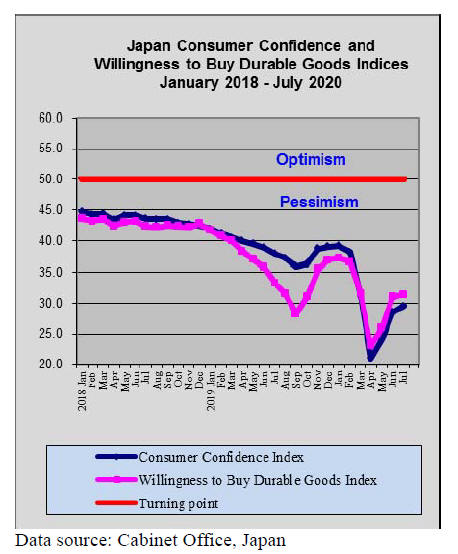
Yen may continue to strengthen against the
dollar
Two issues affected the dollar yen exchange rate at the end
of July, US/China tensions and the rise in infections in the
United States.
The ¡®safe-haven¡¯ yen recently strengthened to its highest
against the US dollar in more than four-months due to a
host of negative news including the rise in coronavirus
cases in the US, a delay in the US stimulus package bill
and the rapidly deteriorating US/China relationship.
The Japanese yen was well below the 107 mark to the
dollar in late July dipping to yen 104 to the dollar. Some
commentators have suggested the yen may rise to 102 if
tensions between the US and China worsen and that this
will be the point at which the Bank of Japan will be
viewing its options.
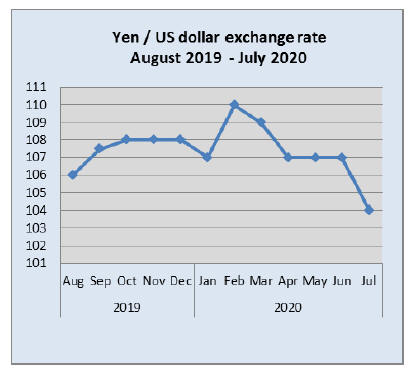
Working from home opens opportunities to
move out
from city
As employees are being encouraged to work from home to
help stem the virus spread many young people are seizing
the opportunity to move to the suburbs where rents are
lower, homes tend to be bigger and the environment more
appealing.
The proportion of those working remotely dropped to 20%
after the state of emergency was lifted dropping down
from 31% in the earlier period. This seems to indicate that
the idea of flexible working faded but now, as a second
wave of infection is on the rise home work has risen.
Interestingly, the survey conducted on working from home
found respondents reporting their work efficiency had
improved.
See:
https://www.japantimes.co.jp/opinion/2020/03/05/editorials/usecoronavirus-crisis-promote-teleworking/#.XyajHbozbIU
Housing starts
June housing starts were better than expected. Compared
to a month earlier June starts were up 12% but year on
year there was a 13% decline which, given the tough
economic situation, was not so bad.

Import update
Wooden door imports
The value of Japan¡¯s imports of wooden doors
(HS441820) has fallen for three consective months up to
May 2020. From March to May there was an almost 20%
drop in the value of wooden door imports.
Year on year, the value of wooden door imports in May
declined 30% adding to the year on year declines seen in
March and April. Of the other shippers, only the US and
Malaysia featured significantly in May imports of doors.

Wooden window imports
The pattern of imports of wooden windows (HS441810)
mirrors that of door imports. Wooden window imports in
May were down 24% year on year but compared to April
there was only a small dip in the value of imports.
Japan¡¯s May wooden window imports in terms of source
were split between shipments from China (44% of the
total) and shipments from the US (almost 30% of the
total). Shippers in Sweden and Malaysia each accounted
for around 8% of the value of imports of wooden
windows.
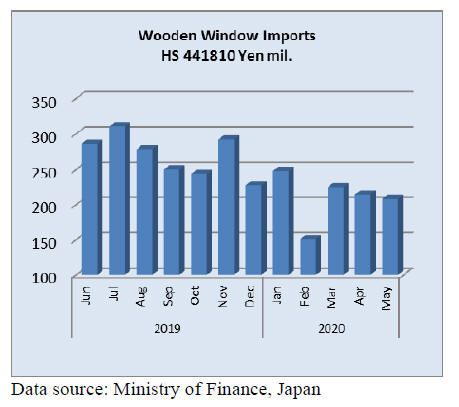
Assembled wooden flooring imports
Over the past 12 months the value of wooden assembled
flooring imports have see-sawed every 2 months but from
the graphic below an overall downward appears to be
emerging which would fit with the trend in import values
of other woodwork items such as doors and windows.
Year on year the value of May imports of assembled
flooring dropped 30% and month on month imports were
down 19%.
Two categories of imports HS441875 and HS441879
accounted for most of Japan¡¯s flooring imports. The
largest category in May, as in other months, was
HS441875 (71% of imports) followed by HS441879 (22%
of imports).
Manufacturers in China accounted for most (60%) of the
HS441875 followed by Vietnam (28%). Imports of
HS441879 in May were fairly even split between
Indonesia and Thailand.
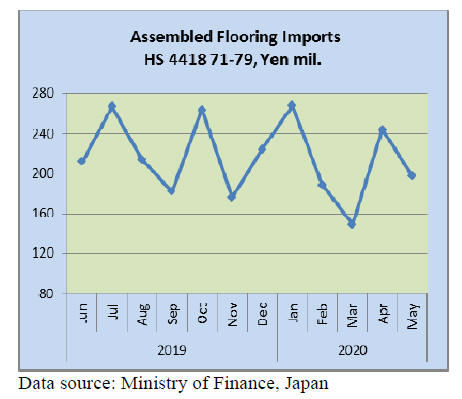
Plywood imports
Up to March this year there was a slight increase in
Japan¡¯s imports of plywood from the top three shippers,
Indonesia, Malaysia and China. However, first in April
and then again in May import volumes trended lower.
Plywood imports from China in May were over 20% down
year on year.
Indonesia and Malaysia are the top shippers of plywood to
Japan accounting for over 80% of all plywood imports. In
May arrivals from Malaysia were up 13% year on year and
imports from Indonesia were up 21% year on year.
Despite the better year on year performance, overall,
import volumes have started to decline.
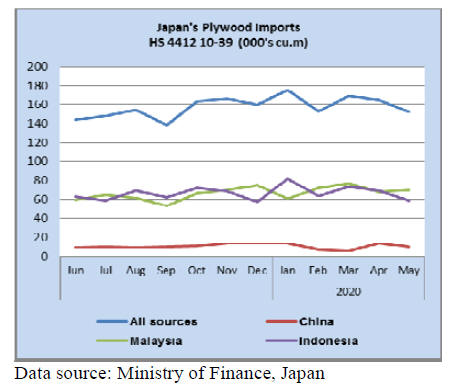 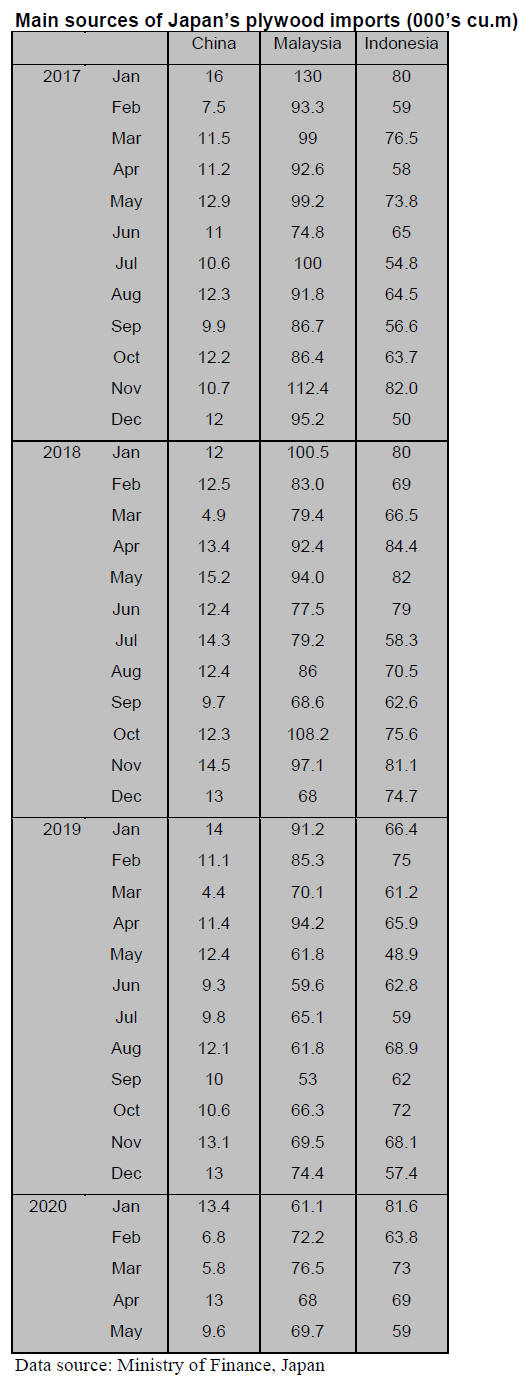
Trade news from the Japan Lumber Reports (JLR)
The Japan Lumber Reports (JLR), a subscription trade
journal published every two weeks in English, is
generously allowing the ITTO Tropical Timber Market
Report to reproduce news on the Japanese market
precisely as it appears in the JLR.
For the JLR report please see:
https://jfpj.jp/japan_lumber_reports/Softwood
plywood manufacturers continue
curtailment
program
Major plywood manufacturers in Japan tie-up and
collaborate to maintain the market by production
curtailment and are determined not to follow down trend
of the market. In the past, to reduce production cost, the
manufacturers over produced and drop the sales prices to
dispose of surplus inventory.
They know that reducing the sales prices does not generate
any new demand and after one reduces the prices, others
steal a march and drop the prices one notch further and
vicious circle continues without any end. This time for the
first time, they communicate with each other and control
the supply volume. They produce only for what the market
needs and wait for recovery of the market.
Seihoku group has been reducing the production by 20%
since last April and some plants curtail more than 20% in
June. Nisshin group plans to expand degree of reduction to
30% in August. Hayashi Plywood has no idea of reducing
the sales prices to promote sales.
Construction works stagnated for three month during April
and June and they will start activating probably in fall
after corona virus problem settles down somewhat and
once things gets moving, man power and distribution
works may get tight toward end of this year.
Sales activities stagnated for almost three months since
last March and dealers¡¯ marketing activities are back in
June and they are trying to catch up short fall of sales but
buyers buy small volume only by uncertain future market.
Precutting plants also face the same uncertain future so
that they try to reduce the inventory as much as possible
and buy on spot basis.
Present market prices of 12 mm 3x6 panel in Tokyo
market are 950 yen per sheet, 40 yen lower than last
month.
National forest plan for 2020
The plan for 2020 is publicised on June 12. Sales plan of
timber and logs is 4,602,000 cbms, 2% more than 2019 but
the demand is likely to decline this year by corona virus
epidemic.
Size of business of national forest depends on the budget.
Initial budget for 2020 is 75.8 billion yen, 1.4 billion yen
less than 2019 but supplementary budget is 1.6 billion yen
so it is about the same as 2019.
Based on the budget, the harvest plan is 7,112,000 cbms of
main cut, 4% more and thinning is 6,958,000 cbms, 1%
more. Sales plan is 2,770,000 cbms of logs, 2% more and
1,832,000 cbms of timber, 2% more.
Both are more than 2019 but by impact of wide spread
corona virus infection, actual management will be flexible.
Particularly as to timber sales, Kyushu regional office held
supply adjustment meeting in May and it decided to hold
some of timber sales.
Hokkaido regional office held the same meeting in May
and decided to postpone time of public auction for timber.
Seven regional offices have decided to extend expiry time
of timber sale by one year without any penalty. It is
unusual that all the regional offices take the same measure
to reduce the supply uniformly.
Time of harvest depends on timber purchaser but there are
request for extension from the purchasers as log prices
keep dropping and some lumber and plywood mills
stopped accepting logs.
New experimental deal is to sell much larger lot of timber
for longer harvesting period. It will designate about ten
locations in Japan in three years from 2020 and each has
200-300 hectares with ten years¡¯ time limit.
It will investigate demand in various regions to see where
the most suitable location is but log supply will increase
all of a sudden by this and likely to collapse balance of
supply and demand so it will keep watching the market
before actual plan is made.
Plywood
Movement of both domestic and imported plywood is
getting stagnating. Domestic manufacturers have been
curtailing the production and are determined to hold the
prices but the market prices are weakening as buyers buy
minimum volume only because of uncertain future market.
Precutting plants also limit the purchase volume by
unpredictable future market. Regular orders are now less
and spot base purchase is increasing.
Imported plywood market continues suffering inactive
movement.
In Tokyo market, large construction works were estimated
to postpone until the summer Olympic Games are over and
they would start up in September but by corona virus
outbreak makes future demand much obscure now so the
importers hesitate to place orders to the suppliers in South
Sea countries.
In middle of March after Malaysia restricted movements
to stop corona virus infection, some placed orders in fear
of total disruption of the supply but the supply actually
continued.
Contracted volume is in Japan now and they are up for
sale but in demand slow market, it is pushing the market
prices down.
Marutama curtails the plywood production
Marutama Industry Co., (Hokkaido), plywood
manufacturer, decided to make every Friday as holiday at
the Tsubetsu plant from June to September so the
operation is four days a week to adjust supply volume.
Marutama¡¯s sales in first half of June was about 5% less
than normal pace and the decrease seems to keep widening
month after month so it decided to quit prospect
production and manufacture by orders only. Curtailment
program will continue for four months through September.
Marutama says it takes two days from accepting order to
actual production. Delivery would take seven days. With
five to six days to spare, the inventory would be reduced
down to two weeks. Log inventories are about two months
so it started to restrict accepting logs now.
The plant produces about 8,000 cbms of both structural
and non-structural plywood but it is preparing to have
lower sales like 20% compared to last year. June¡¯s
working days are 22 so production should drop by 13%.
Closing account of wood building materials
manufacturers
Earnings performance of seven major wood building
materials manufacturers for the term ended March 2020
shows sales are almost unchanged from previous term and
some marked record high sales. Majority enjoyed rush-in
demand before the consumption tax hike in October 2019
then suffered plunged market on the rebound.
Demand of building materials was active in the first half
then dropped sharply in the second half as housing starts
declined.
On profit, there is difference among companies. While
cost of raw materials and transportation continue to
increase, some succeeded to pass higher cost onto sales
prices and rationalization of manufacturing cost and others
failed.
Daiken Corporation registered the highest profit. Sales of
interior materials like flooring was active for not only
residential but for public and commercial buildings.
Then in June 2019, two of subsidiary companies in the
U.S.A. and Teio Flooring in October participated as
consolidation group, which contributed high profit.
Nihon Flush Company marked higher sales and profit for
three straight terms. It expanded the business in China and
started dealing with seventeen new developers in China.
Noda Corporation marked higher sales and higher profit. It
switched floor base material from imported South Sea
hardwood plywood to domestic softwood plywood and
now share of domestic flor base is more than 50%, which
contributed to reduce impact of high cost of imported
plywood. Nankai Plywood enjoyed busy sales of cabinet
and marked higher sales and profit for four consecutive
terms.
Wood One Co. Ltd. pushed price hike of the products so
marked higher sales after three terms. Also by reduction of
sales and general administrative expenses, ordinary profit
and operating profit recovered.
Eidai Co. Ltd. suffered damages by typhoons in 2018 then
closed particleboard plant in Yamaguchi so sales dropped
in two terms and loss but with all-out effort to improve the
performance, loss amount is less than previous term.
Asahi Woodtech Corporation had firm sales in the first
half then dropped some in the second half. Marketing cost
increased after it expanded showrooms and increase of
transportation and ware house so the profit was lower than
previous term.
|